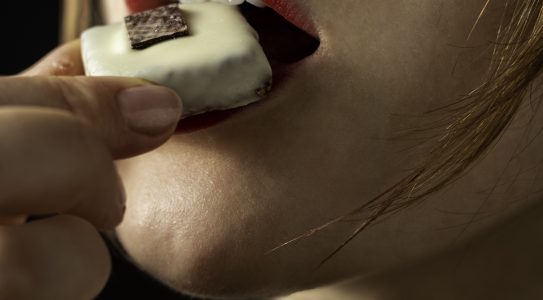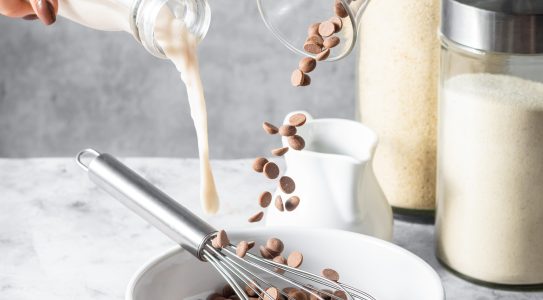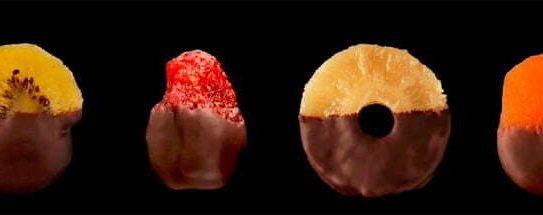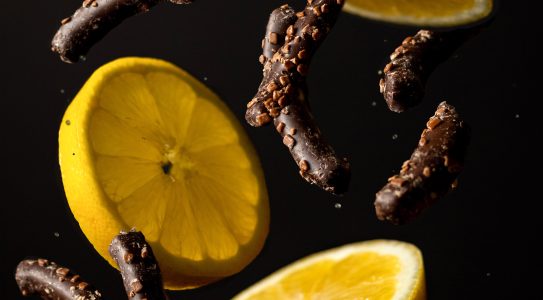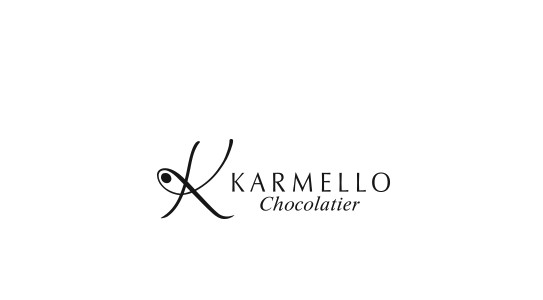Tasting
If you want to consciously explore and taste chocolate, it’s best to celebrate the tasting appropriately. This allows you to try different varieties and compare their appearance, aroma, taste, and consistency.
Even if many exquisite delicacies ended up in your shopping cart, during the tasting you should not try more than three or four varieties at once, because the senses of taste and smell are not able to accept and evaluate an unlimited number of aromas. The same applies to testing fragrances in perfumeries.
To regain the ability to experience new sensations between individual samples, you should take a few sips of water and eat a piece of white bread. Due to the sensitivity of the palate, it seems logical to start with chocolate with the lowest cocoa content, gradually preparing for the taste of high-percentage varieties. It is also recommended to choose a tasting theme. We taste either only products made from pure cocoa or chocolate varieties with specific additions or fillings, for example only with fruits or spices.
Tasting requires time and calmness. This applies to both chocolate and pralines. Before tasting, they should “breathe” at room temperature for two to three hours so that they can release their aromas in an optimal way.
The chocolate bar should be cut into pieces with a sharp knife before consumption, and these should be broken down into even smaller pieces. The pralines should be cut in half to be able to thoroughly inspect the filling as well.
SENSES EXPERIENCE
During the tasting, the whole world of various sensations opens up, which affect all senses:
SIGHT. A visual test, used to assess the condition of selected pieces, requires good lighting first and foremost. The attractive packaging already catches the eye and invites you to discover the treasure inside. The color of the chocolate, as homogeneous as possible – from milky white to almost black – and its beautiful matte shine should immediately catch the eye. The chocolate should also be characterized by a smooth, pore-free bottom. Smooth edges after breaking and a compact structure are a clear criterion for high-quality chocolate. Chocolate that is too dry will be brittle and crumbly. Chocolates with a higher cocoa content are usually slightly harder. Pralines should have a perfect surface and refined shapes and fillings.
HEARING. The first of the auditory sensations is the exciting rustling when opening the packaging. You can also listen to the chocolate: breaking a high-quality chocolate bar is accompanied by a distinct crack.
TOUCH. When it comes to chocolate, its texture is also important. Good quality chocolate should feel smooth to the touch. With pralines, you should also be able to feel a smooth, elastic structure under your fingertips.
SMELL. The nose can enjoy a rich bouquet of aromas, similar to wine. Dry smoky aromas of honey or marzipan gradually emerge, as well as vanilla or caramel notes. The aromas should be balanced, without any dominant ones. Lower quality products often have strong smoky aromas and artificial additives, such as vanillin.
Perception can be trained. Those who consciously “decode” aromas often will soon learn to recognize them better. During tasting, it is important to avoid proximity to foreign sources of smells, such as flowers or scented candles, in order to truly discover the delicate aromas of chocolate.
TASTE. Finally, the moment arrives: refined chocolate melts in the mouth. Delicacy, that well-known sweetness, speaks volumes to connoisseurs about the time of conching. Biting into it, as well as breaking it, should produce a clearly audible snap, rather than a grinding sound reminiscent of sand between teeth. It is important to taste individual aromas on the tongue. Depending on the blend, traces of nuts, exotic aromas, and smoky notes can be sensed.
Professionals, like with wine, deal with the sweetness or acidity, consistency of chocolate, harmony of aromas, and finish. A piece of chocolate or praline should not be bitten into, but rather allowed to melt on the tongue. Filled chocolates should be chewed a bit at the beginning to release the aromas.
After the pleasure of the palate, the taste can be examined more thoroughly. Typical questions include: did a taste remain after the chocolate melted? If so, was it more similar to a delicate milk taste, or did cocoa aromas dominate? Were sweetness and cocoa content balanced appropriately? Do individual ingredients of the praline cause separation of taste territories or do they merge into harmonious taste sensations?
A very general rule when evaluating taste is that very sweet products do not have multi-layered aromas. Another rule is that the more sophisticated the chocolate, the more intense the taste sensations will be. Above all, however, the following premises should be followed: one should enjoy, taste, dream, and immerse oneself in chocolate in peace. This is more important than an overly sober, almost scientific approach to tasting.
THE RIGHT SETTING
Sophisticated chocolate creations work great for solo performances, whether as a small treat or a consciously celebrated pleasure. But a good soloist also shines in collaboration with other great performers, supporting even their strongest sides.
Chocolate complements and enhances coffee or tea exceptionally well. For a long time, it has also been a great match for high-proof partners such as rum, cognac, or whisky. Chocolate and wine as a pair are a fairly recent but increasingly popular discovery among connoisseurs.
CHOCOLATE SOLO
Of cold beverages, milk pairs particularly well with chocolate. Thanks to its rather mild taste and lecithin content, this combination complements each other nicely. Milk is considered, among other things, an ideal accompaniment to chocolate fondue.
Anyone devoted to tasting different chocolate flavors and wanting to refresh their taste buds after each sample should drink plain water. Among the tips, there is even a suggestion to sip a light hibiscus tea during chocolate tasting. The flavor of hibiscus is said to be somewhat similar to that of cocoa.
CHOCOLATE FOR COFFEE AND TEA
Cocoa, coffee, and tea are true friends, delicious natural products that have become favorites in Europe thanks to their aromas. Chocolate in solid form has long been enjoyed with coffee or tea. These three raw materials develop their aromatic qualities during fermentation, releasing similar taste notes in cocoa, coffee, and tea.
An example of a traditional combination of cocoa and coffee is the old drink of the Turin aristocracy, bicerin. In the form of a mixture of cocoa and coffee, it is one of many espresso variants in Italy. Mocha pralines or coffee beans coated with the finest dessert chocolate are another extraordinary combination.
The aromas of well-known tea varieties, such as citrus in Earl Grey and natural nutty Darjeeling, find a suitable companion in cocoa, so they can be chosen as a great complement to chocolate products – just like some flavored teas. Citrus aromas of orange tea are considered an ideal partner for dark chocolate. Creative distributors even offer combinations of tea and chocolate in joint packages.
CHOCOLATE AND WINE
The combination of wine and chocolate is like a dreamy celebrity couple. Initial doubts that the relatively high water content in wine would not be able to break through the rich fat content of chocolate were long ago overcome. Today, there is agreement on the choice of partners, and many common features in the aromas of both products have even been found.
If you want to pair wine with chocolate, you should opt for high-quality products. Keep in mind that the quality of chocolate cannot be guaranteed solely by its high cocoa content, but also by the quality of all its ingredients. Also, not every wine is suitable for chocolate.
Milk chocolate with low cocoa content, which is closer in taste to almonds and nougat and characterized by fruity notes, pairs best with full-bodied, fruity white wines. The higher the cocoa content in milk chocolate, the better it will pair with sweet, noble spirits and those made from carefully selected grapes.
Dark chocolate with high cocoa content requires a high alcohol content in wine. Strong, oak barrel-aged red wines are particularly well-suited to this type of chocolate.
For combined tastings of both products, it is recommended to choose only pure chocolates. The main theme should be chocolate products from one plantation, one vintage, or one type of grain. Foreign flavors and fillings, such as nuts or brittle, disrupt the experience of cocoa and wine aromas.
CHOCOLATE AND HIGH-ALCOHOL BEVERAGES
Rum, cognac, or whiskey, as well as fruit distillates and those made from grape press residues leftover from wine production, have long been enjoyed with beautifully decorated chocolate products. Cocoa and high-alcohol content create an ideal combination. New creations, both in the alcohol and chocolate industries, are shaping a new, exciting sphere of pleasure.
As a general rule of thumb for pairing chocolate and alcohol, chocolates with high cocoa content are definitely better and more interesting partners for spirits. Connoisseurs recommend alcohols made from blends of berries, apricots, and cherries. In the company of a strong partner, they can withstand raspberry-scented alcohols, which in combination with chocolate can ignite real fireworks of pleasure.
